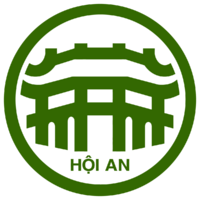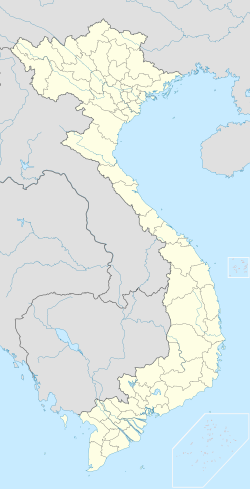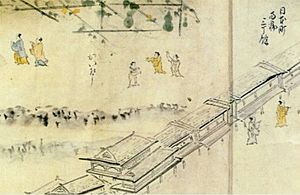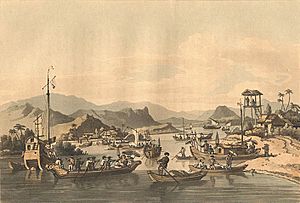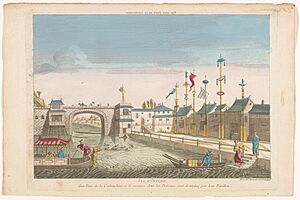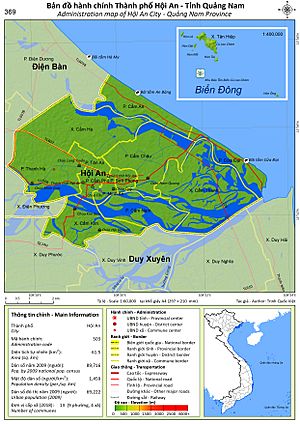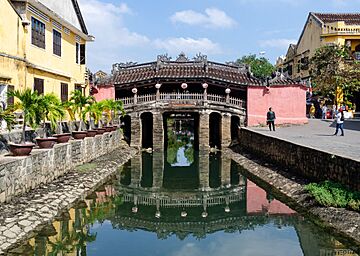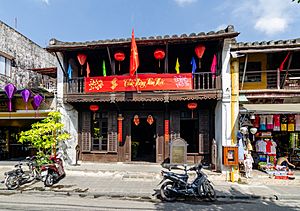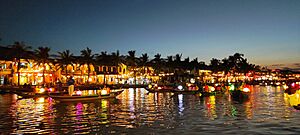Hội An facts for kids
Quick facts for kids
Hội An
Thành phố Hội An
会安
|
||
|---|---|---|
| Hội An City | ||
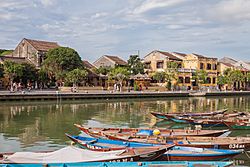
View of the old town
|
||
|
||
| Country | ||
| Province | Quảng Nam Province | |
| Area | ||
| • Total | 60 km2 (20 sq mi) | |
| Population
(2018)
|
||
| • Total | 152,160 | |
| • Density | 2,540/km2 (6,600/sq mi) | |
| Climate | Am | |
| UNESCO World Heritage Site | ||
| Official name | Hoi An Ancient Town | |
| Criteria | Cultural: (ii), (v) | |
| Inscription | 1999 (23rd Session) | |
| Area | 30 ha (74 acres) | |
| Buffer zone | 280 ha (690 acres) | |
Hội An is a beautiful city in Vietnam with about 120,000 people. It's located in Quảng Nam Province. This city is super special because UNESCO made it a World Heritage Site in 1999. This means it's a place with amazing history and culture that needs to be protected.
Hội An is also part of the Cù Lao Cham-Hội An Biosphere Reserve. This area was recognized in 2009 for its important natural environment. In 2023, Hội An joined the UNESCO Creative Cities Network. This shows it's a city known for its creativity and culture.
The historic part of Hội An, called Old Town Hội An, is a great example of a trading port from the 15th to the 19th century. Its buildings and streets show a mix of local and foreign styles. A famous landmark there is the covered "Japanese Bridge", which is very old, from the 16th or 17th century.
Contents
What's in a Name?
The name Hội An means "peaceful meeting place" in Vietnamese. It comes from Chinese words. In the past, people in Western countries called the town Faifo. This name came from "Hoi-pho," which was a shorter way to say "Hội An phố" (the town of Hội An).
Hội An has also had other Vietnamese names like Hải Phố and Hoài Phố. When the Champa kingdom was around, it was called Lam Ap Pho.
Hội An's Journey Through Time
Early History: Cham Period
From the 7th to the 10th centuries, the Chams were in charge of the important spice trade. This made them very rich. The Chams were people who spoke Austronesian languages. They created the Kingdom of Champa, which covered a large part of central and southern Vietnam.
In the early days, Mỹ Sơn was their spiritual center, Trà Kiệu was their political capital, and Hội An was their main trading city. The river system was very important for moving goods between the mountains and other countries like Laos and Thailand.
Vietnamese Period: A Bustling Port
In 1306, the Vietnamese and Chams made a peace agreement. The Cham king gave two provinces to Đại Việt (the old name for Vietnam). Later, in 1471, Emperor Lê Thánh Tông of Đại Việt took over Champa. Hội An then became part of Vietnam and the capital of Quảng Nam Province.
In 1535, a Portuguese explorer named António de Faria tried to set up a big trading center in Hội An. From 1570, southern Vietnam was controlled by the powerful Nguyễn lords. They were very interested in trade, so Hội An grew into a busy port. It became the most important trading port on the South China Sea.
Hội An was a unique town, with a Japanese area on one side of the "Japanese Bridge". This bridge, built by Japanese merchants, is special because it's covered and has a Buddhist temple attached to it.
In the 18th century, Chinese and Japanese traders thought Hội An was the best place to trade in all of Southeast Asia. The city was a key link for trade between Europe, China, India, and Japan, especially for ceramics. Old shipwrecks show that Vietnamese pottery was sent as far as Egypt!
Hội An's importance as a trading port started to fade at the end of the 18th century. This was partly because of a rebellion that was against foreign trade. Also, the river mouth started to fill up with sand, making it harder for big ships to reach the port.
Because of these changes, Hội An remained mostly untouched for the next 200 years. It kept its old charm and buildings.
Bringing Hội An Back to Life
In the 1990s, a Polish architect and conservator named Kazimierz Kwiatkowski helped bring Hội An back into the spotlight. He worked hard to preserve the city's old buildings and history. Today, there's a statue of him in the city. It shows the good relationship between Poland and Vietnam.
Now, Hội An is a popular place for tourists. People love its history, old buildings, and traditional crafts like textiles and pottery. Many hotels and resorts have been built. The port and boats are still used for fishing and for taking tourists on tours.
Hội An's Climate
Hội An has two main seasons: a rainy season and a dry season. The average temperature is warm, around 29°C (84°F) all year.
- Hottest time: June to August, with temperatures sometimes reaching 38°C (100°F) during the day.
- Coldest time: November to January, with an average temperature of 20°C (68°F).
- Rainy season: September to January, with heavy rains that can cause floods. This can sometimes affect tourism.
- Dry season: February to May, when the weather is very pleasant, with moderate temperatures and less humidity.
The best time to visit the offshore Cù lao Chàm islands is from May to the end of August. This is when the seas are calm and the wind changes direction. This short period is also the busiest time for local tourists.
Exploring Hội An's Heritage
In 1999, Hội An's old town was named a World Heritage Site by UNESCO. It's a great example of a Southeast Asian trading port from the 15th to 19th centuries. Its buildings show a mix of local and foreign styles.
More and more tourists are visiting Hội An. This has led to new ways to explore the area. You can go around by motorbike, bicycle, kayak, or motorboat. The Thu Bon River is still very important for fishing and transport, just like it was hundreds of years ago. Kayak and motorboat tours are becoming popular activities for visitors.
Hội An is also famous for its unique food. The local dishes mix flavors from East and Southeast Asia. Many cooking classes are offered where tourists can learn to make Cao lầu. This is a special noodle dish of the city.
The Hoi An wreck was a shipwreck found near the Chàm Islands in the 1990s. It was from the late 15th or early 16th century. Teams found almost 300,000 items from the ship! This shows how important Hội An was for trade.
Another fun event is the Hoi An Lantern Full Moon Festival. It happens every full moon. People celebrate their ancestors and wish for good luck. They exchange flowers, lanterns, candles, and fruits.
Sometimes, too much tourism can be a problem. In 2019, Hội An was listed as a place where too many tourists might harm its culture and nature. This has affected the environment of the Chàm Islands-Hội An Marine Protected Area.
Hội An's Museums
Hội An has several museums that tell the story of the area. The Hoi An Center for Cultural Heritage Management and Preservation manages these museums. You need a special ticket to enter them.
- Museum of History and Culture: This museum is in an old pagoda built in the 17th century. It shows items from different time periods, from the first settlers to French colonial times.
- Hoi An Folklore Museum: Opened in 2005, this is the biggest wooden building in the old town. It has 490 items showing folk arts, traditional jobs, and the daily life of Hội An people.
- Museum of Trade Ceramics:
This museum, started in 1995, is in a restored wooden building from 1858. It has pottery from Persia, China, Thailand, and India. This proves Hội An was a major trading port.
- Museum of Sa Huỳnh Culture: This museum, opened in 1994, has over 200 items from the Sa Huỳnh culture. These were the first people to live in Hội An, over 2000 years ago. It's considered a very special collection of Sa Huỳnh artifacts in Vietnam.
- Precious Heritage Art Gallery Museum: This museum shows photos and items collected by French photographer Réhahn. He spent 10 years exploring Vietnam.
- Hội An Museum: This is another history museum in the city.
Delicious Food in Hội An
Hội An is known as the "banh mi capital of Vietnam" by CNN. Banh Mi is a tasty Vietnamese sandwich made with a baguette, meat, and fresh herbs.
Cao lầu is a famous dish from Hội An. It has rice noodles, meat, greens, and herbs, served with a little bit of broth. It's a bit like Japanese udon. The water for the broth traditionally comes from the Ba Le Well, which is thought to be from the 10th century.
Other local foods you might enjoy include:
- Mi quang noodles
- Banh bao banh vac
- Hoanh thanh
- Com ga (chicken with rice)
- bánh xèo (a crispy pancake)
- Sweet corn soup
- Baby clam salad
A local chili sauce called Ớt Tương Triều Phát is also made here. You can also find herbal teas with natural ingredients like licorice, cinnamon, and lemongrass. These are popular drinks for tourists.
Hoi An Lantern Festival
The Hoi An Lantern Festival is a famous cultural event in Hoi An, Vietnam. It's a celebration of light, color, and old traditions. This bright and magical festival happens on the 14th day of each lunar month, when the moon is at its brightest.
In 2023, the festival dates included February 5, March 6, April 5, and so on. It offers a wonderful experience for both locals and visitors. All year long, the festival shows off Hội An's rich history. Thousands of lanterns light up the old town and the peaceful Thu Bon River.
The Hoi An Lantern Festival is very special to both locals and visitors. It's a way to celebrate Vietnam's culture and history, bringing people together. During the festival, the whole town is decorated with glowing, handmade lanterns. This creates a dreamlike atmosphere that takes you back in time. The festival shows the unique mix of Chinese, Japanese, and European influences in Hội An.
Besides the beautiful lights, the festival also has lots of street food, traditional music, and special ceremonies. These activities let you experience the rich traditions of Vietnam.
Visitors to the Hoi An Lantern Festival can enjoy many activities. As the sun goes down, the town's streets glow softly with lanterns. One of the best parts is releasing floating lanterns on the Thu Bon River. This symbolizes sending away worries and bad luck, and welcoming good fortune.
Traditional music and dance shows happen in different places around town. These give you a peek into Vietnam's artistic past. Plus, you can try a delicious variety of street food, from savory dishes to sweet treats. This makes the festival a true food lover's dream. The Hoi An Lantern Festival continues to charm everyone who attends. It remains a key part of Hội An's culture and a must-visit festival around the world.
Gallery
See also
 In Spanish: Hội An para niños
In Spanish: Hội An para niños


